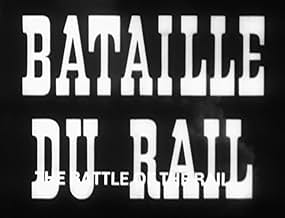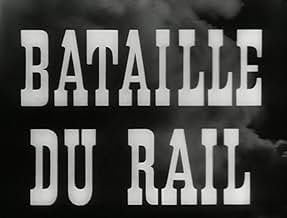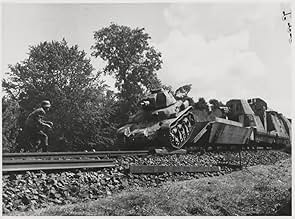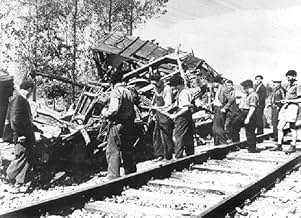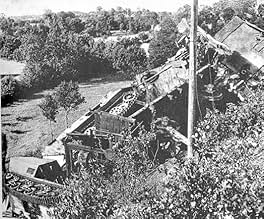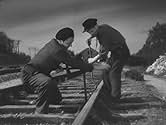IMDb RATING
7.0/10
1.4K
YOUR RATING
Recounts the courageous efforts by French railroad workers who were part of an organized resistance during German World War II occupation.Recounts the courageous efforts by French railroad workers who were part of an organized resistance during German World War II occupation.Recounts the courageous efforts by French railroad workers who were part of an organized resistance during German World War II occupation.
- Awards
- 3 wins & 1 nomination total
Marcel Barnault
- Cheminot
- (as Barnault)
Jean Clarieux
- Lampin
- (as Clarieux)
Jean Daurand
- Cheminot
- (as Daurand)
Lucien Desagneaux
- Athos
- (as Desagneaux)
François Joux
- Cheminot
- (as Joux)
Pierre Latour
- Cheminot
- (as Latour)
Robert Le Ray
- Chef de gare
- (as Leray)
Pierre Lozach
- Cheminot
- (as Lozach)
Pierre Mindaist
- Cheminot
- (as Mindaist)
Léon Pauléon
- Chef de gare St-André
- (as Pauleon)
Fernand Rauzéna
- Cheminot
- (as Rauzena)
Michel Salina
- Allemand
- (as Salina)
Charles Boyer
- Narrator
- (voice)
- (uncredited)
- Director
- Writers
- All cast & crew
- Production, box office & more at IMDbPro
Featured reviews
Although there have been more nuanced, psychologically penetrating filmic depictions of French resistance under Nazi occupation, none has matched the sheer immediacy of René Clément's feature film debut. It represents a natural progression from his pre-war documentaries and indeed the early part is filmed in a documentary style with no clear delineation of character but changes tack dramatically when news comes through of the Allied landings and the Maquis plan greater acts of sabotage to prevent the Germans from moving armoured trains to Normandy.
Based upon real events and featuring many of the courageous participants in the Battle of the Rails of 1944, Clément uses cinéma vérité techniques and Russian-style montage to build momentum and suspense, culminating in the unforgettable derailment of the train convey which is shot from three different angles. Suffice to say the film's most powerful scene is the execution by firing squad of six randomly chosen railway workers. This is a superlative combination of image and sound as their deaths are accompanied by trains whistling in defiance. The post-sync dubbing of the mainly non-professional cast is pretty good and this viewer at any rate is intrigued as to who supplied the German voices. Clément has also been sure to use the strongest, most characterful faces for the close-ups.
It seems that the French suffered from collective amnesia following the liberation and Clément made a brave call for his film might have come too soon and been too close to home but its triumphalism ensured its great critical and commercial success whilst arguably paving the way for Alexander Esway's hugely popular 'Le Bataillon du Ciel' the following year. One cannot help but wonder whether John Frankenheimer was aware of this film when making 'The Train' twenty years on.
As well as being a moving testament to the kind of bravery of which very few are capable it marks, on a purely filmic level, the emergence of a special directorial talent that was to go from strength to strength.
Based upon real events and featuring many of the courageous participants in the Battle of the Rails of 1944, Clément uses cinéma vérité techniques and Russian-style montage to build momentum and suspense, culminating in the unforgettable derailment of the train convey which is shot from three different angles. Suffice to say the film's most powerful scene is the execution by firing squad of six randomly chosen railway workers. This is a superlative combination of image and sound as their deaths are accompanied by trains whistling in defiance. The post-sync dubbing of the mainly non-professional cast is pretty good and this viewer at any rate is intrigued as to who supplied the German voices. Clément has also been sure to use the strongest, most characterful faces for the close-ups.
It seems that the French suffered from collective amnesia following the liberation and Clément made a brave call for his film might have come too soon and been too close to home but its triumphalism ensured its great critical and commercial success whilst arguably paving the way for Alexander Esway's hugely popular 'Le Bataillon du Ciel' the following year. One cannot help but wonder whether John Frankenheimer was aware of this film when making 'The Train' twenty years on.
As well as being a moving testament to the kind of bravery of which very few are capable it marks, on a purely filmic level, the emergence of a special directorial talent that was to go from strength to strength.
René Clément directed this exceptional film which captures an important but often ignored part of the Allied war effort in WWII. It chronicles the efforts by the French railway workers to hinder the German war machine. What makes the film work wonderfully is the non-professional actors--like the Neo-realist actors in post-war Italian films (such as by DeSica and Rossellini). This gives the movie a great sense of realism--almost like a documentary that was somehow filmed as events really took place--though it was made just after the war.
The film begins sometime after the German occupation began--it's never exactly certain. During this time, random acts of sabotage occur but they are mostly annoying and are seemingly unorganized. However, partway through the film, the Resistance receives word that the Normandy invasion has occurred. Suddenly, the full extent of the French Resistance is obvious, as the entire effort to use the rails to reinforce the German army are frustrated in many, many ways--ranging from sabotaging the tracks and equipment to even attacks on the trains themselves by partisans.
"La Bataille du Rail" ("The Battle of the Rails") works very well--mostly because in addition to the non-actors working in the film, the director and writers (one of which was the director himself) used a lot of tense little vignettes in the film to draw in the viewer. Perhaps some today might find it all a bit boring (after all, they are more interested, perhaps, in seeing the newest Brandon Frazier film), but as a history teacher, I think it's a must-see! Wonderful.
By the way, you can't blame the film makers for this, but the print I saw was pretty shabby. It had a lot of scratches and the white captions were poor--blending into the scenes at times and also, occasionally, mistranslated or using jargon that is too technical (full of railroad terms and jargon). I would LOVE to see this film restored and re-captioned!
The film begins sometime after the German occupation began--it's never exactly certain. During this time, random acts of sabotage occur but they are mostly annoying and are seemingly unorganized. However, partway through the film, the Resistance receives word that the Normandy invasion has occurred. Suddenly, the full extent of the French Resistance is obvious, as the entire effort to use the rails to reinforce the German army are frustrated in many, many ways--ranging from sabotaging the tracks and equipment to even attacks on the trains themselves by partisans.
"La Bataille du Rail" ("The Battle of the Rails") works very well--mostly because in addition to the non-actors working in the film, the director and writers (one of which was the director himself) used a lot of tense little vignettes in the film to draw in the viewer. Perhaps some today might find it all a bit boring (after all, they are more interested, perhaps, in seeing the newest Brandon Frazier film), but as a history teacher, I think it's a must-see! Wonderful.
By the way, you can't blame the film makers for this, but the print I saw was pretty shabby. It had a lot of scratches and the white captions were poor--blending into the scenes at times and also, occasionally, mistranslated or using jargon that is too technical (full of railroad terms and jargon). I would LOVE to see this film restored and re-captioned!
I usually stop watching films when I discover that it has subtitles but I'm glad that I didn't with this one. Stopping German supplies and reinforcements reaching Normandy contributed greatly to the advancement of the Allies, many trains, and rail tracks, were destroyed by the RAF in the run up to the invasion but the events in this film also helped greatly.
After the war the French were very keen to show that they didn't just capitulate ASAP but had an active resistance movement but in the many WWII history books I've read their overall contribution to the victory In Europe is considered to be minimal.
Regardless of that this film is very well worth watching.
After the war the French were very keen to show that they didn't just capitulate ASAP but had an active resistance movement but in the many WWII history books I've read their overall contribution to the victory In Europe is considered to be minimal.
Regardless of that this film is very well worth watching.
For cinema enthusiasts, it is important to learn that the value of trains in the field of cinema has always been justly understood by filmmakers as truthful portrayals of trains have been extremely useful in making films which have become extremely popular with critics as well as with viewers. It would be appropriate to state that most of the films about war have an air of authenticity due to the realistic depiction of trains in them. It would not be an exaggeration to state that war films are popular due to the portrayal of trains in them. La Bataille Du Rail/The Battle of the Rails is the best example of a war film with trains and their impact on war as its major plot. The success of this film is due to the efforts of ordinary railway workers in war time France who were quick to realize that the damage to railway system in occupied France would be a key weapon in their fight against Nazi Germany. Those who favor technology in cinema would be shocked to learn how professionally the massive annihilation of trains was carried out in "The Battle of the Rails" despite the evident lack of technology. In 1946, this film by René Clément won a jury prize at Cannes Film Festival. In recent times, La Bataille Du Rail/The Battle of the Rails has been hailed as one of the classics of world cinema as it was shown in "Cannes Classics" section during 63rd Cannes International Film Festival held in 2010. Hardcore cinema enthusiasts would be thrilled to learn that it has been fully restored by INA in France where it can also be watched on DVD as well as Blu Ray formats.
A hidden gem l just discovered !! Tells it like it was !! Dirty , hard , people died . Very good de-railment scene towards the end !! A real derailment excellently shot !
Did you know
- TriviaIn part financed by what had been the Resistance as a way of showing international audiences what the French population had been facing under Nazi oppression. The Resistance was also keen to let the world know that they had been actively involved in disrupting the German war machine in France as the international perception at the time was that the French had capitulated and collaborated a little too easily with their Nazi captors.
- GoofsRailway worker tapping Morse code just repeats letter "V" most of the time with only a few exceptions.
- Crazy credits(in cast) et Les cheminots de France
- ConnectionsFeatured in Cannes... les 400 coups (1997)
- How long is The Battle of the Rails?Powered by Alexa
Details
- Release date
- Country of origin
- Official sites
- Languages
- Also known as
- The Battle of the Rails
- Filming locations
- Gare SNCF, Saint-Brieuc, Côtes-d'Armor, France(first scenes, train station)
- Production companies
- See more company credits at IMDbPro
- Runtime
- 1h 25m(85 min)
- Color
- Sound mix
- Aspect ratio
- 1.37 : 1
Contribute to this page
Suggest an edit or add missing content

